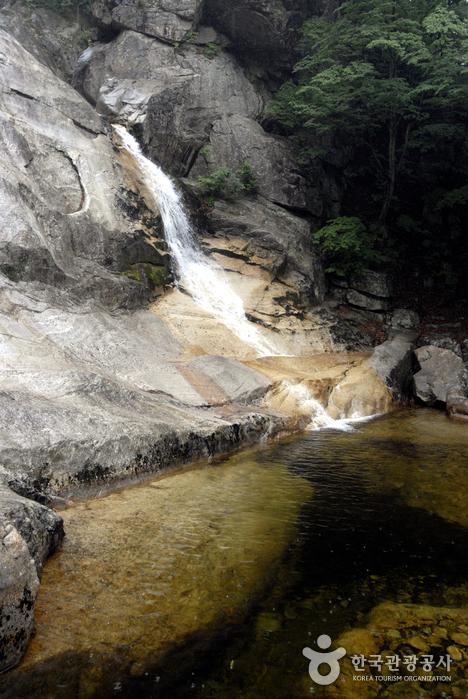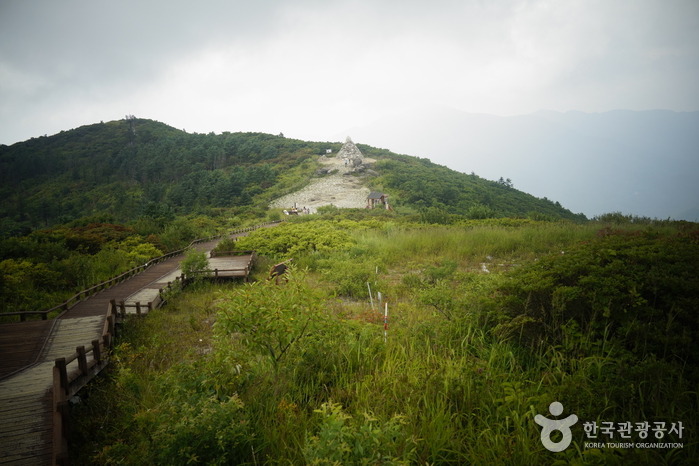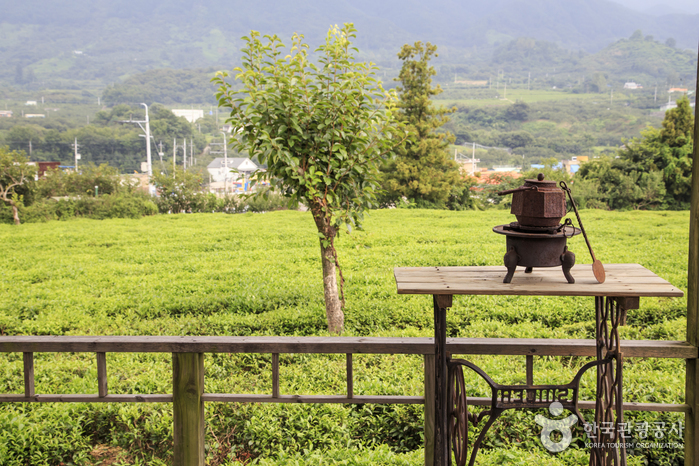Gurye Cheoneunsa Temple (천은사(구례))
16.2 Km 14499 2021-10-02
209, Nogodan-ro, Gurye-gun, Jeollanam-do
+82-61-781-4800
Located north of Gurye on Jirisan Mountain, and built during the Unified Silla Period, Cheoneunsa Temple is one of the three great Buddhist temples of Jirisan Mountain. Cheoneunsa Temple is believed to have been built by Monk Deokun and Monk Seru from India in AD 828 during the 3rd year of King Heungdeok. Because it initially laid next to spring water as clean and cold as a morning dew, the temple was also called Gamrosa, meaning Sweet Dew Temple. The spring water was rumored to clean one’s body and soul, leading to crowd of Buddhist monks to visit the temple. During King Chungryeol’s reign, the temple was named the Best Temple in the south.
The temple was burned down during the Imjin War (1592-1598) and then later rebuilt and renamed Cheoneunsa. Legend has it that while the temple was being rebuilt, a large serpent often came out of the spring. When the serpent was finally captured and killed, the spring waters suddenly dried up. Hence the name Cheoneunsa, meaning Disappearance of Spring Water, was given.
Hotel Jirisan Haetsal [Korea Quality] / 지리산햇살 [한국관광 품질인증/Korea Quality]
16.6 Km 61 2021-03-27
386-3, Hwaeomsa-ro, Gurye-gun, Jeollanam-do
+82-61-783-9600
This hotel is located about 300 m away from Jirisan National Park’s Nambu Visitor Center. Built with red bricks and having an orange roof and grass lawn, the hotel resembles a country home. The hotel is surrounded by Jirisan Mountain to the back, and the Masancheon Stream, a branch of Seomjingang River, flowing through the area offers a great view for the visitors. There are five types of rooms, accommodating 2, 4, and 6 guests. A cleaning service is offered every day. The rooms have white walls and wood floorboards, tastefully furnished in a minimalist style. The wide windows offer a great view of the lawn and the mountains. All rooms other than the 4-person ondol (under-the-floor heating system) room are bedrooms, and the 6-person Special Room comes with a wooden terrace. Visitors can enjoy grilling by the valley. The hotel is located about 10 min by car from Gurye Public Bus Terminal. Hwaeomsa Temple, a temple with a thousand-year history, is located only 2 km away from the hotel, while a 10-min drive brings one to Gurye Fifth-day Market and “Unjoru House, Gurye,” which is the Folk Cultural Heritage No. 8 of Korea.
Nogodan Guesthose (노고단 게스트하우스&호텔)
16.7 Km 1001 2024-08-01
40 , Hagwan 1-gil, Gurye-gun, Jeollanam-do
+82-61-782-1507
Nogodan Guesthouse & Hotel is located in Gwansan-ri, Gurye-gun, Jeollanam-do, and is popular with weekend trippers and family vacationers visiting Jirisan National Park. Local hot spring water (high in traces of germanium) is provided in all rooms, so residents can relieve their fatigue in a hot spring bath after hiking; while from the hotel’s rooftop garden residents can enjoy fine views of Jirisan Mountain. A shuttle service to Nogodan, where the Jirisan trail starts, costs 20,000 won per person for the round trip. And at the 1st floor Buen Camino Restaurant & Pub l you can enjoy Jirisan black pork barbecue, Jirisan zucchini pancake, and seasonal vegetable side dishes.
Guryonggyegok Valley (구룡계곡)
16.7 Km 19779 2024-04-07
Guryongpokpo-gil, Namwon-si, Jeonbuk-do
+82-55-972-1000
Guryonggyegok Valley, a 3 kilometer-long valley in the northern part of the Jirisan National Park, located in Namwon, Jeollabuk-do, is just the place to enjoy a panoramic view of the unusually shaped rocks and precipitous cliffs. Under the Guryongpokpo Falls, located at the peak of the valley, is a small pond called, ‘Yongso’ (meaning ‘dragon pond’). Legend has it that a dragon lived here before it ascended to heaven. Visitors can tour the valley by driving along the skyway, an extension of the tourist road of Jirisan Mountain, or take an invigorating hike up a mountain by taking the Jeongnyeongchigan route, which extends along the valley to Baemsagol Valley(Banseon) and Nogodan Peak.
Jirisan National Park (Nogodan Peak Section) (지리산국립공원 (지리산 노고단))
16.8 Km 41718 2021-12-25
356, Hwaeomsa-ro, Gurye-gun, Jeollanam-do
+82-61-780-7700
Jirisan National Park covers a vast amount of land in three provinces, including one city and three counties. The countless mountain peaks both large and small blend harmoniously, giving off a comforting ambiance. The valleys feature streams, waterfalls, and more natural attractions beautiful all year round. The mountain is the starting point for the Seomjingang River, which flows into the southern sea.
The park is home to many plants and animals, including the Asiatic black bear. There are many hiking paths crossing the park; it is recommended to make a plan for the courses in advance, checking the lengths and time required. As Jirisan Mountain changes with the different seasons, hikers can enjoy various aspects of the mountain’s terrain. However, some areas will be closed off for hikers' safety in the case of incliment weather or to prevent forest fires in the dry season.
Jirisan Spa Land (지리산온천랜드)
17.0 Km 36195 2020-07-13
261, Jirisanoncheon-ro, Gurye-gun, Jeollanam-do
+82-61-780-7800
Jirisan Spa Land is home to a large open-air hot spring facility that uses 100 percent natural germanium mineral waters containing no chemical additives. The natural germanium mineral water in the spa prevents various kinds of geriatric illnesses, speeds up metabolism and improves your body’s immune system. The water also helps blood circulation and digestion, and stabilizes your body temperature.
A bath themed with the 12 Asian zodiac animals, a Japanese cypress bath, a utopia-themed bade pool and a waterfall bath are located in the open-air spa area. Apart from the huge spa area, Jirisan Spa Land also has a hotel equipped with 60 high-end modern bedrooms and subsidiary facilities. Each guest room uses natural germanium mineral water.
Hamyang Jianjae Pass (함양 지안재)
17.4 Km 0 2024-02-08
119-3 Guryong-ri, Hamyang-eup, Hamyang-gun, Gyeongsangnam-do
Jianjae Pass, renowned for its picturesque winding roads, is a celebrated attraction in Hamyang. It was also selected as one of the "100 Most Beautiful Roads in Korea." While the pass is navigable by car, it's best appreaciated by stopping to soak in the views from the observation deck. An observatory is situated at the end of Jianjae Pass, providing visitors with an excellent vantage point for capturing stunning photographs.
Road to Jirisan (지리산 가는길)
17.4 Km 0 2024-02-08
Jirisanganeun-gil, Hyucheon-myeon, Hamyang-gun, Gyeongsangnam-do
Road to Jirisan is a 12 km road from Hamyang-eup to the vicinity of Jirisanjeilmun Gate. You go through Jianjae Pass and Odojae Pass to Macheon, where you will find Jirisanjeilmun Gate and Jirisan View Park. From here, you can see the entire ridge of Jirisan Mountain, and there are also hiking trails to Beophwasan Mountain and Sambongsan Mountain. The road is also renowned for its biking trails and attracts many motorcycle enthusiasts.
Hadong Agyang [Slow City] (경남 하동 악양 [슬로시티])
18.6 Km 11881 2021-02-02
357, Agyangseo-ro, Hadong-gun, Gyeongsangnam-do
+82-55-880-2370
Agyang-myeon is located in Hadong-gun, Gyeongsangnam-do, surrounded by Jirisan Mountain and cut through by the Agyangcheon Stream. The unique geographical features allow the village to grow 80% of all persimmons harvested in Hadong. The area is also famous for its green tea, brought over from China during the Unified Silla period.
Maeam Tea Museum (매암차문화박물관)
18.8 Km 23640 2020-07-04
348, Agyangseo-ro, Hadong-gun, Gyeongsangnam-do
+82-55-883-3500
Maeam Tea Museum originally started from a tea garden established in 1964 by Gang Seongho. The tea museum features hands-on programs that allow participants to directly experience the process of making tea and also learn about proper tea culture. It aims to become an experiential museum.

![Hotel Jirisan Haetsal [Korea Quality] / 지리산햇살 [한국관광 품질인증/Korea Quality]](http://tong.visitkorea.or.kr/cms/resource/03/2708603_image2_1.jpg)


![Hadong Agyang [Slow City] (경남 하동 악양 [슬로시티])](http://tong.visitkorea.or.kr/cms/resource/06/2026206_image2_1.jpg)

 English
English
 한국어
한국어 日本語
日本語 中文(简体)
中文(简体) Deutsch
Deutsch Français
Français Español
Español Русский
Русский